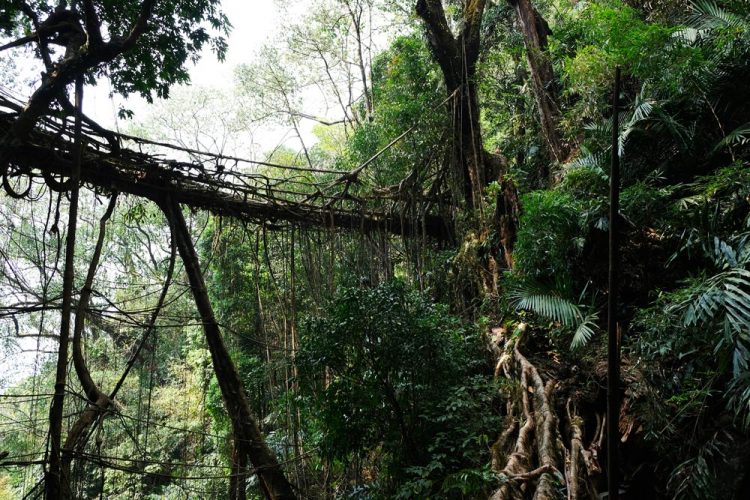Living bridges: How traditional Indian building techniques can make modern cities more climate-friendly

Meghalaya-Brücke: Brücken aus den verschlungenen Luftwurzeln des Gummibaums Ficus elastica sind mechanisch äußerst stabil. Copyright-Notice: Ferdinand Ludwig Rights usage terms: Frei fuer Berichterstattung ueber die TU Muenchen unter Nennung des Copyrights.
Inaccessible valleys and ravines lead from the North East Indian Meghalaya plateau to the wide plains of Bangladesh. In the monsoon months the mountain streams in the forests swell into torrential rivers.
In order to cross these rivers, the indigenous Khasi and Jaintia peoples have long built their bridges out of the living aerial roots of the Indian Rubber Tree, Ficus elastica. “Stable bridges like these made of closely intertwined roots can reach more than 50 meters in length and exist for several hundreds of years,” says Ferdinand Ludwig, Professor for Green Technologies in Landscape Architecture at TUM.
He analyzed 74 such living bridges together with Thomas Speck, Professor for Botanics at the University of Freiburg. “There has already been a lot of discussion of the Living Root Bridges in the media and in blogs, but there have only been a few scientific investigations up to now”, says Ludwig.
“Knowledge about the traditional Khasi building techniques has hardly ever been put down in writing in the past,” adds Wilfrid Middleton from the TUM Department of Architecture. The researchers conducted interviews with the bridge builders in order to gain a better understanding of the building process. The researchers took several thousand photographs which they then used to create 3D models, providing insight into the complex root structure. The team also mapped the locations of the bridges for the first time.
A bridge that builds itself
“The building process usually begins with a planting: a person planning a bridge plants a Ficus elastica seedling on the bank of a river or the edge of a ravine. At a particular point during the plant's growth it develops aerial roots,” says Speck.
The aerial roots are then wound onto a framework of bamboo or palm stems and directed horizontally over the river. Once the roots have grown as far as the opposite bank, they are implanted.
They develop smaller daughter roots which are directed to the bank as well where they are implanted. Due to constant plant growth and the application of various winding techniques the roots of the Ficus elastica form highly complex structures which create stable, safe bridges. Newly growing roots are integrated in the existing structure again and again.
The properties of the Ficus elastica play an important role: “The roots react to mechanical loads with secondary root growth. In addition, the aerial roots are capable of forming inosculations: Possible injuries result in what are called inosculation and callus formation, a process also familiar from wound healing of trees.
Thus for example two roots which are pressed together can grow together and inosculate,” says Speck. The bridges are made and maintained by individuals, families or by communities that include several villages which use the bridge. “Living bridges can thus be considered both a man-made technology and a very specific type of plant cultivation,” says Speck.
Building for future generations
It takes decades if not centuries to complete a living bridge made of Ficus elastica. Often many generations are involved in the building process. “The bridges are a unique example of future-oriented building. We can learn much from this: today we are faced with environmental problems that will not only affect us, but also subsequent generations. We should approach this topic as the Khasis have,” says Ludwig.
Living buildings can cool down cities
“The findings relating to the traditional techniques of the Khasi people can promote the further development of modern architecture,” says Ludwig, himself an architect. He integrates plants as living building materials in his plans and structures. In 2007 he founded a new field of research centered on this approach: “Baubotanik”.
By integrating plants in building we can better adapt to the impacts of climate change, he says: “Stone, concrete and asphalt heat up rapidly at high ambient temperatures, so that heat stress is particularly relevant in cities. Plants provide cooling and improve the climate in the city. Baubotanik means no extra space has to be created for plants; instead plants are much more an integral component of structures.”
Prof. Dr. Ferdinand Ludwig
Technical University of Munich (TUM)
Professorship for Green Technologies in Landscape Architecture
Tel: +49 892 8922 570
ferdinand.ludwig@tum.de
Ludwig, F., Middleton, W., Gallenmüller, F. et al. Living bridges using aerial roots of ficus elastica – an interdisciplinary perspective. Scientific Reports 9, 12226 (2019) doi:10.1038/s41598-019-48652-w
https://www.nature.com/articles/s41598-019-48652-w
Media Contact
All latest news from the category: Architecture and Construction
Newest articles

Innovative 3D printed scaffolds offer new hope for bone healing
Researchers at the Institute for Bioengineering of Catalonia have developed novel 3D printed PLA-CaP scaffolds that promote blood vessel formation, ensuring better healing and regeneration of bone tissue. Bone is…

The surprising role of gut infection in Alzheimer’s disease
ASU- and Banner Alzheimer’s Institute-led study implicates link between a common virus and the disease, which travels from the gut to the brain and may be a target for antiviral…

Molecular gardening: New enzymes discovered for protein modification pruning
How deubiquitinases USP53 and USP54 cleave long polyubiquitin chains and how the former is linked to liver disease in children. Deubiquitinases (DUBs) are enzymes used by cells to trim protein…



